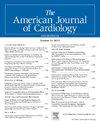Systematic Review and Meta-analysis of Short-Term Outcomes in Patients Following Protected High-Risk PCI
IF 2.1
3区 医学
Q2 CARDIAC & CARDIOVASCULAR SYSTEMS
引用次数: 0
Abstract
Surgical revascularization is still considered the gold standard for patients with complex coronary artery disease and left ventricular dysfunction. The advent of Impella has sparked growing interest, yet current evidence on its efficacy remains inconclusive. All studies reporting outcomes beyond 30 days outcomes of pPCI with any Impella device were included. Pooled effect of estimated outcomes was calculated according to a random-effect model with generic inverse variance weighting. Primary endpoint was all-cause mortality. Secondary outcomes were myocardial infarction, repeat revascularization, rehospitalization for heart failure and stroke. Six studies globally encompassing 1,581 patients were included in the quantitative analysis. Median age was 70 years old (IQR 69 to 72) with a median left ventricular ejection fraction (LVEF) of 27 % (SD ± 6) and a SYNTAX SCORE of 31 (IQR 29 to 35). Impella 2.5 was the most common micro axial flow pump used to support high-risk PCI. All-cause of death was observed in 13.4% (95% CI: 10.4 to 16.4) of patients at 6 months median follow-up. Myocardial infarction occurred in 5.8% (95% CI 3.4 to 8.1) of patients, repeat revascularization in 9.1% (95% CI: 4.8 to 13.3) of patients, stroke in 1.6% (IQR 1.2 to 2.1) of patients and, finally, heart failure rehospitalization in 8.4% (95% CI 3.3 to 13.6) of patients. In conclusion, for high-risk patients, PCI with the Impella device represented a viable strategy with an acceptable risk profile when surgical revascularization is not an option, and a poor prognosis is predicted.
高危PCI术后患者短期预后的系统评价和meta分析
手术血运重建术仍然被认为是复杂冠状动脉疾病和左心室功能障碍患者的金标准。Impella的出现引发了越来越多的兴趣,但目前关于其功效的证据仍不确定。所有报告使用任何Impella装置的pPCI结果超过30天的研究均被纳入。估计结果的合并效应根据通用方差逆加权随机效应模型计算。主要终点为全因死亡率。次要结局为心肌梗死、重复血运重建术、心力衰竭和中风再住院。定量分析纳入了全球6项研究,共1581例患者。中位年龄70岁(IQR 69-72),中位左室射血分数(LVEF)为27% (SD±6),句法评分为31 (IQR 29-35)。Impella 2.5是支持高危PCI最常用的微轴流泵。中位随访6个月时,13.4% (95%CI: 10.4-16.4)的患者出现全因死亡。5.8% (95%CI 3.4- 8.1)的患者发生心肌梗死,9.1% (95%CI 4.8-13.3)的患者发生重复血运重建术,1.6% (IQR 1.2-2.1)的患者发生卒中,最后8.4% (95%CI 3.3-13.6)的患者发生心力衰竭再住院。综上所述,对于高危患者,在不能选择手术血运重建术且预后不良的情况下,使用Impella装置进行PCI是一种可行的策略,具有可接受的风险。
本文章由计算机程序翻译,如有差异,请以英文原文为准。
求助全文
约1分钟内获得全文
求助全文
来源期刊

American Journal of Cardiology
医学-心血管系统
CiteScore
4.00
自引率
3.60%
发文量
698
审稿时长
33 days
期刊介绍:
Published 24 times a year, The American Journal of Cardiology® is an independent journal designed for cardiovascular disease specialists and internists with a subspecialty in cardiology throughout the world. AJC is an independent, scientific, peer-reviewed journal of original articles that focus on the practical, clinical approach to the diagnosis and treatment of cardiovascular disease. AJC has one of the fastest acceptance to publication times in Cardiology. Features report on systemic hypertension, methodology, drugs, pacing, arrhythmia, preventive cardiology, congestive heart failure, valvular heart disease, congenital heart disease, and cardiomyopathy. Also included are editorials, readers'' comments, and symposia.
 求助内容:
求助内容: 应助结果提醒方式:
应助结果提醒方式:


